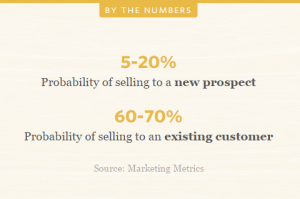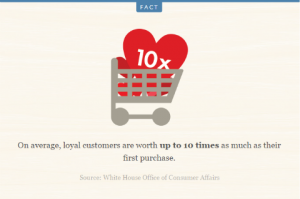Contradiction is all around us. For as long as I can remember, I’ve been told that the customer is always right. But as a customer, I often feel constrained by shop assistants and service providers unwilling to budge on a policy or process. Early in my career as a client service manager, I did my best to bow to clients’ often unrealistic demands, with a smile even. But I rarely saw the same from other client service staff and relationship managers. And I’ve often heard murmurings among friends and family that good customer service is dead.
So… is the customer always right? And should they always get their way?
Customer service is key
I don’t think many people would argue that customer service is one of the golden keys to unlocking business success and growth. Good customer service results in satisfied clients, and satisfied clients come back for more. The more they come back, the more loyal they become. And loyal customers tell their friends. Studies have also shown that it is much easier to sell to existing clients than new prospects and a loyal customer’s value in terms of purchases increases over time.
That’s the good news story. The bad news story is fairly depressing. Here are some facts about bad customer service:
- 78% of consumers have bailed on a transaction or not made an intended purchase because of a poor service experience.
- A typical business hears from only 4% of its dissatisfied customers.
- It takes 12 positive experiences to make up for one unresolved negative experience.
- News of bad customer service reaches more than twice as many ears as praise for a good service experience.
Bottom line… if you want a successful business, you simply can’t afford to give customers a bad service experience.
So how high should we jump?
My answer to this question might surprise you. How high? Well, not very. And sometimes not at all.
Let me explain.
Let’s explore what most customers want. Apart from the obvious need to buy a product or service they perceive to be of value at a price that is reasonable to them, I think that most customers simply want to be heard and understood. I truly believe that most clients don’t need or want you to bend over backwards. They just want to have their needs met and if they have an issue, they want to be heard. It’s simple.
So when you get a narky client calling and emailing ten times a day or an irate person in your store, I’m willing to bet you a lot of money it’s because they either haven’t got the value they were expecting or they feel that no-one is listening or understands them.
So back to the original question… how far backward do you bend?
You bend far enough to let them say their piece or express their need, offer them a solution via your product or service, and if your product or service is not suitable for them, you let them walk away.
A common misconception is that you have to put on the hard sell, but the real trick is to show them the benefits of buying your product or service and let them decide if it meets their needs. If it doesn’t, then these people are not your target market, so you need to let them go.
So that’s why I say not to jump very high. Just high enough to make sure that you understand their need and offer your best solution. After that, it’s out of your hands and no amount of jumping or bending will change the situation.
What about the clients from hell?
Most of us have a “client from hell” story. Maybe they started out fine but progressively got more demanding, or less responsive, or any myriad of possibilities. Again, I can guarantee that more often than not, something you did (or didn’t do) along the way changed them. Take the time to have the conversation – understand their needs, offer them your solution, and if it still doesn’t work, let them go.
But ensure you communicate with clarity and honesty. Difficult or unhappy clients are best dealt with in person (or over the phone if necessary) and never via email or other electronic means. It’s impossible to really get your point across, and ensure they interpret it the way you meant it, over email or text.
A case study
I had a client once who was perpetually grumpy. After months of doing everything I could to appease her every request and meet every demand, I was very frustrated and upset to get negative feedback from her on a customer satisfaction survey. In her feedback, she wrote that I didn’t really understand her needs and as a result, I was too reactive in my approach.
After some reflection, I realised she was right. I was so busy lurching from request to request and trying to just be accommodating, I neglected my most fundamental role, which was to understand her business’ needs and meet them with appropriate solutions. I immediately set up a meeting with her to “reset” our business relationship. I had her spell out exactly what her objectives and expected outcomes were and most importantly, what she needed from me. The conversation had finally begun. After that, everything was different. We started working effectively together, I worked in a more measured way and we soon grew to respect and understand each other. Win-win.
When to just walk away
But of course, it’s impossible to please everyone and sometimes it’s best to just let an unhappy client go. You know they will probably talk about their experience with others and it may be detrimental to you and your business. The important thing here is to keep your cool and always be respectful. Don’t do or say anything that they can use against you. Acting with the highest level of integrity is your best course of action in these scenarios.
Final comments
Customers are not always right but we need them. So rather than simply yielding to their every whim, it’s better to take the time to really listen and understand their needs to see if we can offer them a real solution. And if we can’t, then it’s OK to let them go, with respect and integrity.
* Feature image sourced from Gratisography.
—
 What did you think of this article? Post your comments and questions below. And if you found this useful, please share with your networks.
What did you think of this article? Post your comments and questions below. And if you found this useful, please share with your networks.
About the Author: Angeline Zaghloul is an expert in business strategy, client management and business processes, and is the Principal of Peer Business Consulting, a Sydney-based consultancy providing strategy and operations support to startups and SMEs. Angeline also publishes a regular blog which provides research, advice and tips on key issues facing businesses.





Pingback: 3 biggest customer service no-no's | Peer Business Consulting